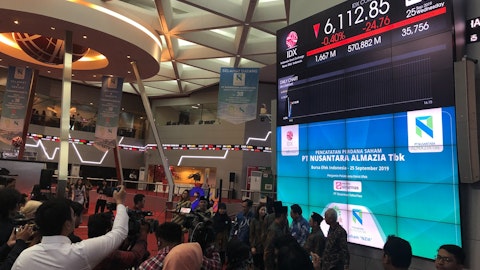Telefonaktiebolaget LM Ericsson (publ) (NASDAQ:ERIC) Q1 2024 Earnings Call Transcript April 16, 2024
Telefonaktiebolaget LM Ericsson (publ) isn’t one of the 30 most popular stocks among hedge funds at the end of the third quarter (see the details here).
Daniel Morris: Hello, everyone, and welcome to today’s presentation of Ericsson’s First Quarter 2024 Results. With me today are Borje Ekholm, our President and CEO; and Lars Sandstrom, Chief Financial Officer. As usual, we’ll have a short presentation followed by Q&A. And in order to ask a question, you’ll need to join the conference by phone. Details can be found in today’s earnings release and on the Investor Relations website. Please be advised that today’s call is being recorded, and I also need to advise you that today’s presentation may include forward-looking statements. These statements are based on our current expectations and certain planning assumptions, which are subject to risks and uncertainties. The actual results may differ materially due to factors mentioned in today’s press release and discussed in this conference call.
We encourage you to read about these risks and uncertainties in our earnings report as well as in our annual report. I’ll now hand the call over to Borje and to Lars for their introductory comments.

Borje Ekholm: Thanks, Daniel, and good morning, everyone. So let me first start off by welcoming my two new colleagues, Lars Sandstrom, our new CFO; as well as Daniel Morris, our new Head of IR. So it’s great to have both of you joining the call and being on Board at Ericsson, so a big welcome. So first, I will cover some key highlights from the quarter before Lars goes through the financials in much greater detail. So during Q1, we continue to execute on our strategy to strengthen our leadership in the mobile networks and drive a focused expansion into enterprise, while of course, continuing to strengthen our culture and operational execution. As expected, our customers remain cautious with their investments and our organic sales decline and with India slowing following the rapid and unprecedented 5G buildout last year.
We continue to view the level of industry investments that’s unsustainably low, but we can’t in reality impact this in the short term. Though what we work on is what we can control, and that’s like the commercial and operational discipline, and of course having a competitive solutions and product portfolio. So despite the market headwinds and difficult market conditions, we maintained our market leading position and delivered a good improvement in gross margin to 42.7%, excluding restructuring charges. For the rest of the year, we expect the mobile networks market to remain weak. External sources estimate that the global RAN market will decline by minus 4%. That looks a bit optimistic to me. However, we see the potential for sales to start to stabilize on a year-over-year basis during the second half.
And then reason for that is, of course, that North America investments are expected to grow for the full-year 2024 and in the second part of the year, we should start to see the benefit from this. But we will, of course, also see the benefit from the recent contract win we had that we announced in the end of last year. We continue to be disciplined in our execution, including proactively taking cost savings measures to ensure that we’re well positioned to maximize shareholder value when the market ultimately improves. We’re still in the early phases of the build out of 5G, but the improvement in the market will ultimately be in the hands of our customers, and that will happen when traffic grows and new use cases can be launched. So in the meantime, we remain fully focused to manage what’s in our control, but at the same time, making the critical investment that reinforces our long-term competitive positioning.
See also 15 Best Places to Retire in Georgia and 10 Dividend Stocks with Over 9% Yield According to Analysts.
Q&A Session
Follow Ericsson L M Telephone Co (NASDAQ:ERIC)
Follow Ericsson L M Telephone Co (NASDAQ:ERIC)
And of course, that includes creating the high performance and programmable networks for the future and exposing their capabilities through a Global Network Platform for network APIs. You’ve seen that revenues in Vonage fell during the quarter, and that’s due to the contract loss we had in Q4, but also our decision to reduce our operations in some countries. Of course, we need to prudently manage the current business in Vonage, but our strategic ambition with Vonage is to build up the Global Network Platform. And during the quarter, we took several steps in our strategy execution by announcing partnerships with Verizon, AT&T, AWS, and KDDI. You heard me say this before, but creating this market will take some time, but we’re seeing good traction in building the ecosystem, which will be ultimately be crucial to drive the next step of digitalization of enterprise and society, leveraging the capabilities of their mobile networks.
And 5G is really a platform technology that allows many different use cases that actually build on that technology. We see very good and solid opportunities on mission critical networks in many parts of the world. And you have seen that during the quarter, we launched something we call the Ericsson Federal Technology Group. And that’s an activity that we can use to serve the different parts of the U.S. government. And we see this as an very interesting opportunity to expand our market for the 5G technology. Let me also briefly touch on the news that our independent monitor has certified our compliance program. This is, of course, a very important step in order to conclude our plea agreement with the DOJ, but our focus on culture and integrity will continue beyond the monitorship.
So with that, I’d like to pass over to Lars to go through the financial details of the quarter.
Lars Sandstrom: All right. Thank you, Borje. Let me start by adding a few additional points on the group before we discuss the segments in more detail. In the quarter, we saw an organic sales decline of 14%. This was primarily driven by Networks. In North America, the rate of decline improved in the quarter and customer inventory levels have now stabilized. As Borje already highlighted, we delivered a good expansion in our gross margin, excluding restructuring charges with 42.7% in Q1. OpEx, excluding restructuring charges was down by SEK 0.8 billion in the quarter with the benefit of our cost saving actions, partially offset by higher variable incentives and inflation. We are working to identify additional efficiencies and believe there is more we can do.
EBITDA, excluding restructuring charges was SEK 5.1 billion in the quarter with a margin of 9.6%. This included a onetime gain of SEK 1.9 billion from the resolution of a commercial dispute. With that, let’s move to the segments. In Networks, organic sales were down by 19% year-over-year as customers continue to be cautious with their investments, and as India slowed as expected, following a rapid 5G build out last year. Despite this, we generated a strong gross margin, excluding restructuring charges of 44.3%. This was driven by our competitive product portfolio as well as our actions on costs. Gross margin was also positively impacted by retroactive IPR licensing revenues. EBITDA, excluding restructuring charges, declined to SEK 4.3 billion compared to SEK 6.4 billion last year and we reached an EBITDA margin of 12.7%.
The decrease in EBITDA reflects continuous cautious customer investment level across multiple geographies, leading to lower sales and lower gross income. As Borje said, we are taking proactive actions to optimize the business and drive efficiencies, and this is already supporting gross margins and driving down operating expenses. In segment Cloud Software and Services, we continue to execute on our strategy to strengthen delivery performance and commercial discipline. Organic sales decreased by 2% compared to last year primarily driven by de-scoping contracts and contract access in managed network services. While this is impacting the top line, these are strategic actions that will position the segment for attractive profitability levels in the future.
We delivered a gross margin, excluding restructuring charges of 37.4%, and EBITDA margins improved year-on-year for a fifth consecutive quarter. Our IPR revenues grew in the quarter with a new 5G patent license agreement and we are confident of delivering future growth benefiting from additional 5G agreements and an expansion into additional licensing areas. The time of growth will vary as we seek to optimize the value of new agreements. In Enterprise, sales were broadly stable overall, with growth in Enterprise Wireless Solutions, offset by a decline in Global Communication Platform. Sales in Global Communication Platform were negatively impacted by an earlier announced loss, low margin customer contract that we lost in Q4 and our decision to reduce our operations in some countries, with the impact expected to continue throughout the year.
Gross margin, excluding restructuring charges, increased to 48.1% with improvements in Enterprise Wireless Solutions and technologies and new businesses. Turning to free cash flow, which was SEK 3.7 billion before M&A in the quarter. This strong improvement compared to last year is due to our operational actions on working capital, including lower inventory levels. Cash flow also improved as large customer projects move out of the intense rollout phase, something that affected working capital last year and is now behind us. Variable incentive payments were also lower compared to last year. Net cash increased sequentially by SEK 3 billion to SEK 10.8 billion, driven by positive free cash flow after M&A and the positive exchange rate effect. And we delivered a return on capital employed of 9.2% in the quarter.
Next, I will cover the outlook. Turning first to sales where we expect seasonality in Mobile Networks to be broadly similar in Q2 to what we have seen in the past. In Networks, average seasonality between Q1 and Q2 has been around plus 8% over the last three years and includes Software and Services, it has been around 13% plus. For the full-year, we expect the RAN market to decline. External sources estimate this decline to be around 4% globally, but as Borje already mentioned, we view this as optimistic. Given our contract win, which will contribute during the second part of the year, we see potential for stabilizing sales on a year-over-year basis during the second half. In Enterprise, we expect sales in Global Communication Platform to continue to be impacted by the recent low margin customer loss and our decision to reduce operations in some countries.





